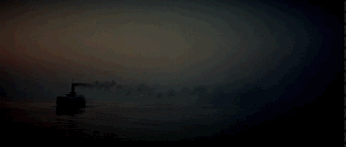Pan left: The opening shot of Visconti’s Death in Venice
As Luchino Visconti's name fades from the screen after the opening credits for Death in Venice (1971), images of a limpid dawn appear accompanied by the Adagietto from Gustav Mahler's Fifth Symphony, which swells rhythmically in unison with the light of the sun, slowly illuminating vaporous clouds. The camera pans left to capture an ink-black smoke trail and then its source, the funnel of a steamer gliding through an iridescent sea. On board, we discover, is Gustav von Aschenbach, a composer arriving for a restorative holiday.
Although it will soon be revealed as Venice, for an instant the location is more like the Thames near Rotherhithe in 1838. Even without its ghostly burden, the small chugging ferry pays homage to Joseph Mallord William Turner's The Fighting Temeraire tugged to her Last Berth to be broken up, 1838. For William Makepeace Thackeray, the boat was a "little demon of a steamer" on its way to Beatson's breakers yard, "belching out foul, lurid, red-hot, malignant smoke."1 It was an image of the ugly future dragging a once glorious warship to its demise. This picture of the heroic ship from the Battle of Trafalgar being dragged up river by a contemporary workhorse to its final desecration was voted Britain's favourite painting in a survey run by the BBC in 2005. In part, this is because it so succinctly encapsulates our nostalgia and our fear, even dread, of the stark, uncompromising present.
Turner's masterpiece then creates the perfect mise en scène for Visconti's filmic interpretation of Thomas Mann's novella Death in Venice (1912). The languid pace of the steamer, and of the camera pan — to the left, not the right, suggesting a backward rather than a forward glance — immediately sets the tone of the film. We are prepared for a gentle unfurling of the past toward a foreseeable denouement. We are primed in those first 89 seconds for what will transpire 2 hours and 15 minutes later, when Aschenbach, having succumbed to the beauty of the Polish boy Tadzio (whom he meets at the Hotel on the Lido), finally reaches out to youth, standing in the sea, before slumping back dead in his deck chair — the residue of his newly dyed black hair, a pathetic attempt to stay the ravages of time, trickling down his cheek.
Turner was also a great interpreter of Venice, documenting it in vibrant watercolours and paintings made during his three trips to the city in the summers of 1819, 1833, and 1840. However, it was not a painting of La Serenissima Visconti chose to echo in his opening sequence, though he easily could have done so. Perhaps the sunsets on the Thames and the dawn over the lagoon at Venice were similar enough to avoid too rigid adherence to geography. More likely it was the embedded notion of death and change, captured so evocatively in the London painting, which became an imperative for his narrative exposition of Mann's novella.
Mann's choice of Venice was calculated, as was Aschenbach's arrival by water. From the sea the city does seem serene and magical, but as Mann describes it in the fifth chapter of his short novel: "This was Venice, the flattering and suspect beauty — this city, half fairy tale and half tourist trap, in whose insalubrious air the arts once rankly and voluptuously blossomed, where composers have been inspired to lulling tones of somniferous eroticism." Behind the façades, along the dark winding Calle, it is dangerous, corrupt and decaying. It offers a false promise, he suggests, as does the beauty of Tadzio with its predictable outcome.
In Mann's original text Aschenbach was a writer, like himself. Visconti recast him as a composer, not Mann but Mahler, whose music inflects the film from the first seconds till the last. Excerpts from the Third and Fifth Symphonies, and most memorably the Adagietto from the Fifth in the famous opening sequence, encapsulate that wistful, anguished sense of inevitability. Indeed the Adagietto is closely related to Mahler's most famous song, with lyrics from a poem by Friedrich Rückert "Ich bin der Welt abhanden gekommen" (I am lost to the world), written in the same creative burst in the summer of 1901. In that poem Rückert could be describing Aschenbach, living on his own, away from the tumult of the world, "in my heaven, in my love, and in my song." It is the disruption of that life, being thrown into the mad desire and uncertainty of the real world, given concrete form in the beauty of the young boy Tadzio, that ruptures his sense of security and safety. Aschenbach had sought a kind of pure beauty in his art, but instead found it in this boy, and the desire it kindles within him leads to an inexorable slide into desperation as his life falls apart. Although it was cholera that killed Aschenbach, Mann, Mahler, and Visconti convince us that it was the beauty of Tadzio (which kept him in Venice when he ought to have left) as well as the failure of his creative instincts to find that beauty in his art, which are the real causes of his death.
Those first languid 89 seconds are some of the most memorable in a long and remarkable film, because they not only encapsulate so much of what we will come to know after our 2 hour journey with Aschenbach, Visconti, Mahler and Mann (and I would like to add Turner into that mix) but because we are prepared so well for what transpires. When we think back on the evocative opening image of the dark steamer coughing up its black smoke into the pristine Venetian lagoon, we realise how the ending in the deckchair on the Lido was, like a Greek tragedy, inevitable.

